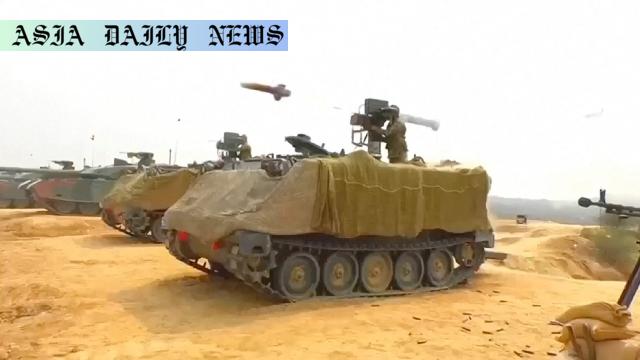Kashmir Attack: India conducted air force drills along highways, while Pakistan launched artillery exercises amid rising tensions.
Tensions between India and Pakistan rise after a Kashmir attack left 26 dead.
India conducted military drills simulating attack effects.
Pakistan showcased artillery and air power in a large-scale exercise.
Observers speculate on the possibility of cross-border retaliation.

Background of Rising Tensions
The longstanding conflict between India and Pakistan over the Kashmir region has once again escalated following a tragic attack on April 22 in Indian-administered Jammu and Kashmir. Gunmen targeted a group of tourists, culminating in the deaths of 26 innocent civilians. Both nations have denied any direct involvement in the attack, yet the tension between the two nuclear-armed neighbors has palpably increased, as evidenced by a series of military exercises conducted soon after. Kashmir, a disputed territory with decades of strife, remains a flashpoint of geopolitical friction between these rival countries.
The Indian Air Force demonstrated its preparedness by conducting a high-profile fly-past and landing drill on an expressway. This maneuver simulated operating from an alternative runway in the event of an attack rendering standard airbases inoperative. On the other side of the border, Pakistan responded with its own show of power. Utilizing long-range artillery units and warplanes during a large-scale exercise, Pakistan’s military leadership reaffirmed readiness and emphasized their resolve against any potential provocations.
Significance of Military Responses
The timing and scale of these military exercises underline the volatile situation between the two nations. Regional observers are drawing attention to these events as potential precursors to further escalation. Given the history of conflicts between the two nations—most recently witnessed during India’s airstrikes in Balakot in 2019—current developments are being monitored closely. Both nations have clearly articulated their stances. While the Indian exercises highlight the need for operational preparedness amidst ongoing hostilities, Pakistan’s response emphasizes its stand to deter any potential policy of aggression or expansion from across the border. Such displays of military might, although symbolic to some degree, also have the potential to exacerbate regional tensions significantly.
Regional and Global Implications
The ongoing developments are not contained within South Asia’s borders. The rising tensions in the region have drawn concern from the international community. Peace in Kashmir—or lack thereof—holds significant strategic implications, particularly given its proximity to key global powers such as China, Russia, and the United States. A potential conflict could disrupt political alliances, trade routes, and peace-building initiatives in the broader Asian region. The direct involvement of international mediators might already be on the horizon as both countries tread the fine line between showcasing strength and preventing war. The response of global leaders to this crisis will shape not only Kashmir’s future but also the broader regional stability in South Asia.
Potential Outcomes
As the military exercises dwindle, attention will increasingly center on India’s next move amid widespread speculation of a cross-border strike. Analysts, however, agree that military solutions are unlikely to resolve the long-standing Kashmir dispute. Diplomacy, though slow-moving and fraught with challenges, remains the most viable path to achieving a sustainable resolution. It is critical for both nations to refrain from entering a zero-sum game that could plunge the region into destructive violence. Peace in Kashmir begins with dialogue and confidence-building measures, ensuring an environment where innocent lives are no longer jeopardized by political and military strife. The regional and global stakeholders must converge in urging both nations toward de-escalation and constructive engagement.



Commentary
Understanding the Gravity of Escalating Tensions
The events unfolding in the aftermath of the April 22 attack in Kashmir underscore the precarious balance of power in South Asia. Both India and Pakistan, nuclear-armed nations with a history of hostility, continue to assert their dominance in a region marked by decades of conflict. As each country strengthens its resolve, ordinary citizens—like the 26 tragically killed in the attack—bear the heaviest burdens. Such incidents remind us of the human cost of geopolitical disputes, a fact that often gets lost amidst strategic posturing and political rhetoric.
Military Exercises: Necessary or Provocative?
Though military preparedness is a cornerstone of national security, exercises such as those recently carried out by India and Pakistan raise crucial questions. Are these drills meant purely as defensive measures, or do they contribute to an already fragile situation? Military actions, even when framed as deterrents, inherently carry the risk of misinterpretation by rival powers. In high-stakes environments like this, one misstep or misjudgment could escalate into a full-scale conflict with dire consequences—not just for India and Pakistan but for the broader region. The emphasis placed on military might should be carefully balanced with parallel investments in diplomacy and peace-building efforts.
Hope for a Peaceful Resolution
Despite the heightened tensions, there is hope for reconciliation. History has shown that even the most entrenched conflicts can be resolved through dialogue and mediation. The international community, including nations with vested interests in South Asia’s peace and stability, must play an active role in fostering negotiations and trust-building measures between India and Pakistan. The focus must shift from retaliatory posturing to collaborative problem-solving for the sake of the millions who call the Kashmir region home.